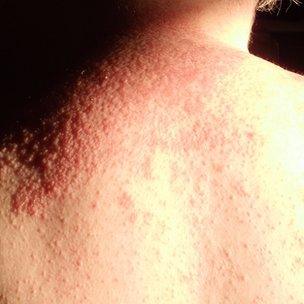Allergy claims prompt Piz Buin suncream chemical removal
- Published

Vicky Hall's back after applying Piz Buin suncream
The healthcare company Johnson & Johnson says it will change the formula for its Piz Buin 1 Day Long suncream after more than 150 people told BBC Watchdog about allergic reactions.
They complained of bright red bumps on the skin, fluid-filled lumps, blisters, itchy eyes and, in one case, a severely swollen face.
The substance thought to be causing the reaction is used in dozens of products.
Doctors are calling for "immediate action" from the industry.
Johnson & Johnson has said it will change the formulation of the suncream from summer next year.
Sophie Holmes, a marketing executive from London, told the Watchdog programme what happened after she applied the Piz Buin cream during a sunny skiing holiday in the Alps this year.
"I came home on the Sunday evening and drove back from France. As we were driving it got worse and worse and worse and started to swell in my face and in my neck, and so I went straight to A&E in London.
"They prescribed me with steroids to reduce the swelling as it was a worry - it was restricting my airways and could become fatal."
Leading dermatologist Dr Ian White from St Thomas' Hospital, London, has identified a preservative known as MI (Methylisothiazolinone) as the likely cause of reactions like Sophie's.
When Watchdog first highlighted this potentially harmful ingredient in June this year, Johnson & Johnson did not amend the formula because it claimed the number of reported instances of reaction was small.
However, since that first report, Watchdog has heard from more than 150 consumers who have suffered adverse reactions to Piz Buin.
Widely used
It is not just Johnson & Johnson that uses the preservative in its products. MI is in many other cosmetic products, and allergies to MI are increasing.
Charity shop manager Vicky Hall, from Liverpool, suffered extreme reactions to Piz Buin and two other cosmetics - and subsequent allergy tests confirmed that MI was the culprit across the three products.
For dermatologists in the UK, the expected rate of allergic reaction from any cosmetic product can be seen in 1-2% of the patients they see.
Data from leading UK dermatology clinics reports that the rate of reaction to MI is over 10%. That is more than twice the level of another ingredient called MDBGN (methydibromo glutaronitrile) which was banned by the European Commission in 2008.
Dr White says: "The frequency of reactions to MI is unprecedented in my experience. We've never seen anything quite like it.
"It is a new phenomenon, and at this present time, there is no suggestion that we have reached the top of that frequency or that it is starting to drop.
"Contact allergy to this permitted preservative is now of epidemic proportions."
In a statement, Johnson & Johnson said: "Piz Buin 1 Day Long provides safe and effective sun protection. It contains only permitted ingredients at levels well within EU standards set by regulators.
"Many substances in our daily life, including ingredients in cosmetic products, may cause irritation in some people with a particular sensitivity. This applies to Methylisothiazolinone, a preservative used to protect products from spoiling, which is found in many consumer and household products.
"We are continuously seeking to improve the effectiveness and consumer experience of our products. As part of this ongoing process we are currently updating Piz Buin 1 Day Long and, from summer 2014, a new formulation that does not contain MI will be available in the UK."
You can watch more about this story on BBC Watchdog at 20:00 on Wednesday, 18 September on BBC 1 and afterwards on iPlayer
- Published1 June 2011
- Published19 January 2011
- Published2 August 2013